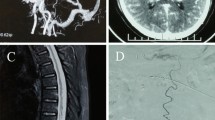Abstract
Background
Spinal dural arteriovenous fistula (d-AVF) is the most common spinal vascular malformations. Management includes endovascular embolization, and/or surgical obliteration of the shunt.
Method
Applied to spinal d-AVF, mini-invasive surgical (MIS) obliteration is described as a mini-open approach using Mast Quadrant™ system. Important anatomical landmarks are reviewed. Indications, advantages, and limitations are discussed, and a step-by-step description of the procedure is presented.
Conclusion
MIS is a good solution to treat d-AVF with a good outcome.



Similar content being viewed by others
Abbreviations
- CT:
-
Computed tomography
- d-AVF:
-
Dural arteriovenous fistula
- min:
-
Minute
- MIS:
-
Mini-invasive surgery
- MRI:
-
Magnetic resonance imagery
References
Day AL, Turkmani AH, Chen PR (2017) Spinal arteriovenous fistulae: surgical management. Handb Clin Neurol 143:189–198. https://doi.org/10.1016/B978-0-444-63640-9.00018-7
Desai A, Bekelis K, Erkmen K (2012) Minimally invasive tubular retractor system for adequate exposure during surgical obliteration of spinal dural arteriovenous fistulas with the aid of indocyanine green intraoperative angiography. J Neurosurg Spine 17(2):160–163. https://doi.org/10.3171/2012.4.SPINE12152
Elsarrag M, Soldozy S, Patel P, Norat P, Sokolowski JD, Park MS, Tvrdik P, Kalani MYS (2019) Enhanced recovery after spine surgery: a systematic review. Neurosurg Focus 46(4):E3. https://doi.org/10.3171/2019.1.FOCUS18700
Flores BC, Klinger DR, White JA, Batjer HH (2017) Spinal vascular malformations: treatment strategies and outcome. Neurosurg Rev 40(1):15–28. https://doi.org/10.1007/s10143-016-0713-z
Gempt J, Jonek M, Ringel F, Preuss A, Wolf P, Ryang Y (2013) Long-term follow-up of standard microdiscectomy versus minimal access surgery for lumbar disc herniations. Acta Neurochir (Wien) 155(12):2333–2338. https://doi.org/10.1007/s00701-013-1901-z
Han J, Cao D, Wang H, Ji Y, Kang Z, Zhu J (2018) Spinal dural arteriovenous fistula presenting with subarachnoid hemorrhage: a case report. Medicine (Baltimore) 97(16):e0513. https://doi.org/10.1097/MD.0000000000010513
Jeng Y, Chen DY, Hsu HL, Huang YL, Chen CJ, Tseng YC (2015) Spinal dural arteriovenous fistula: imaging features and its mimics. Korean J Radiol 16(5):1119–1131. https://doi.org/10.3348/kjr.2015.16.5.1119
Koch C (2006) Spinal dural arteriovenous fistula. Curr Opin Neurol 19(1):69–75. https://doi.org/10.1097/01.wco.0000200547.22292.11
Patel NP, Birch BD, Lyons MK, DeMent SE, Elbert GA (2013) Minimally invasive intradural spinal dural arteriovenous fistula ligation. World Neurosurg 80(6):e267–e270. https://doi.org/10.1016/j.wneu.2012.04.003
Sorenson T, Giordan E, Cannizzaro D, Lanzino G (2018) Surgical ligation of spinal dural arteriovenous fistula. Acta Neurochir (Wien) 160(1):191–194. https://doi.org/10.1007/s00701-017-3381-z
Author information
Authors and Affiliations
Corresponding author
Ethics declarations
Ethics approval
Not applicable.
Informed consent
Not applicable.
Conflict of interest
The authors declare no competing interests.
Additional information
Key points
1. Spinal d-AVF are the most common spinal vascular malformations.
2. Treatment is essential to prevent symptom progression and promote recovery.
3. Spinal arteriography is the gold standard test to diagnose spinal d-AVF.
4. Identifying the level of d-AVF and the great Adamkiewicz artery is paramount.
5. When endovascular occlusion is not possible, surgery is the alternative.
6. MIS technique is safe and efficient.
7. Exclusion of the d-AVF is performed with a clip proximal to the shunt and distal coagulation and cutting.
8. Preoperative implantation of a radiopaque marker can be carried out by radiologists to avoid error level especially in thoracic region.
9. Fluorescein angiography is performed to better visualize the d-AVF.
10. Watertight closure of the dura is essential.
Publisher's note
Springer Nature remains neutral with regard to jurisdictional claims in published maps and institutional affiliations.
This article is part of the Topical Collection on Vascular Neurosurgery - Arteriovenous malformation
Supplementary Information
Below is the link to the electronic supplementary material.
Supplementary file1 (MP4 302134 KB)
Rights and permissions
About this article
Cite this article
Albader, F., Serratrice, N., Farah, K. et al. Minimally invasive microsurgical treatment of spinal dural arteriovenous fistula: how I do it. Acta Neurochir 164, 1669–1673 (2022). https://doi.org/10.1007/s00701-022-05200-2
Received:
Accepted:
Published:
Issue Date:
DOI: https://doi.org/10.1007/s00701-022-05200-2




